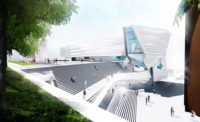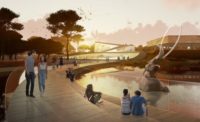Swiss architect Peter Zumthor’s controversial design for the Los Angeles County Museum of Art (LACMA) has turned into the most serious cultural issue in the city in the last decade. This Tuesday, April 9th, it will come to a head as the Los Angeles County Board of Supervisors considers the project for a $125 million construction grant that could determine whether or not the project proceeds.
Notoriously slow, Zumthor has spent ten years and counting (earning something north of $10 million) on a design to replace a quartet of existing buildings on the eastern side of the LACMA campus. Severely compromised by changes over the decades, the three pavilions, designed by Los Angeles architect William Pereira in the 1960s, and the Art of the Americas Building, by Norman Pfeiffer that opened in 1986, are uninspired designs that have not aged gracefully, and they need seismic upgrading.
No one wept, then, when LACMA director Michael Govan hired Zumthor to wipe out the four structures to build a replacement inspired by the curving outline of the adjacent prehistoric tar pit, a pool that had presumably swallowed up woolly mammoths and saber-toothed tigers in the Pleistocene era. Turns out that that particular inky pool, filled with a viscous liquid, was actually a late 19th-century asphalt quarry, so Zumthor had to scotch that generative metaphor. The curves remained, however, though morphing into another metaphor for Zumthor: an Incan temple emerging from the sands of the desert (L.A. apparently conjures exotic imagery for an architect who practices in a small village in the Swiss Alps).
Zumthor’s sprawling amoebic form, with cantilevered roofs, was then re-configured to leap over Wilshire Boulevard to a parking lot the museum owned on the opposite corner, to order to keep all the galleries on one level. (Govan believes there’s a 50 percent drop-out rate of visitors if they have to climb a staircase.) That opened the museum to instant controversy: would it feel like a freeway overpass? Would it attract terrorists parking truck bombs? Wasn’t Wilshire Boulevard a city-designated historic corridor?
Govan and Zumthor implied all along that the area available and permitted for construction on the campus side of Wilshire was not large enough to accommodate the square footage of Zumthor’s proposed $650-million building. But the design process has been anything but transparent—contradicting the physical metaphor of transparency that Zumthor had designed into his sprawling proposal: he has glazed the entire perimeter of the structure for that indoor-outdoor feeling associated with southern California architecture since the post war Case Study houses.
The opacity of the process became obvious two weeks ago when the Final Environmental Impact Report (EIR) was released, revealing surprising figures. The LACMA press department has said that the overall square footage and the net gallery space of the new structure roughly equaled that of the buildings about to be demolished.
But the EIR blew that fib: clearing through the weeds of the 577-page report, the numbers reveal that the project now represents a 105,108 square foot reduction of overall space, and in the galleries, a net 53,000 square foot loss. Since the report came out, Govan has been busy performing damage control with open letters explaining how the contraction of the Zumthor project actually represents expansion if you count other buildings built on the campus since 2000.
Concerned citizens writing letters to The Los Angeles Times are wondering why on earth the museum was downsizing when, in fact, what was needed was more gallery space for the tens of thousands of artworks that have been acquired since Pfeiffer’s pavilion opened more than 30 years ago. Govan himself has acquired some 27,000 artworks during his 13-year tenure.
But even before the EIR detonation, the trained architectural eye could see what LACMA and Govan had been saying didn’t square with the obvious visual fact that four, mostly four-story, buildings were being replaced by a single-story structure lifted on pylons.
What tipped me off that a spatial audit was required was that no floor plans have been made public. There was no way to know just what the museum was getting for its $650 million. The museum had released only a series of slick interior and exterior renderings depicting a curving concrete-and-glass bridge of galleries elevated on pods, swanning gymnastically over Wilshire Boulevard, with dreamy galleries inside.
The problem for Govan and the LACMA board is that during the decade that Zumthor mulled over the project, the price of construction in Los Angeles increased by 35%, and so to stay within the $650 million budget, the building had to get smaller, and shed some of the pricier distinguishing features, like its roof of solar panels and the curved floor-to-ceiling glass sheets of its all-glass facade. In addition, Govan and Zumthor jettisoned functions wholesale, such as offices, which are now exiled to an office building across the street, where the 15-year lease will cost the museum $3.6 million annually, not counting build-out.
Stripped of necessary functions already contained by the existing buildings, the Zumthor design would be dysfunctional even without the need for off-site support space: it has no event space, classrooms, back-of-house infrastructure, storage, library, or the usual cloakroom for school children’s back packs.. Even the auditorium seating has been reduced from 700 seats to 300. The fact that the south end of the bridge now lands on a LACMA parking lot means that the Zumthor design cannibalizes land that could be used for future expansion or profitable development.
The Zumthor design does fulfill Govan’s plan to radically change LACMA’s original mission as an encyclopedic museum—the largest west of the Mississippi—by breaking down the longstanding scholarly departments. But is that appropriate? For the proposed building, galleries are not designed to correspond to the needs of LACMA’s specific collections. Instead, according to the renderings, there are generic galleries of various sizes that will no longer accommodate departmental collections, but will instead host theme shows drawn across departmental lines. The galleries will no longer distinguish between hanging a contemplative Chinese scroll versus an explosive Anselm Kiefer or a high-energy Lucian Freud. And despite owning 130,000 artworks, dating back to archaic times, LACMA will no longer be a multi-cultural teaching museum but a string of galleries that will lose their scope, their focus and their authority.
LACMA’s proposed shrunken building is perhaps the most counterproductive project undertaken by any museum in America over the last generation; in terms of space lost for the price paid, it’s highly questionable whether Los Angeles can afford the cultural cost of building it. Govan began his museum career at the Guggenheim in New York, when Frank Gehry’s Guggenheim in Bilbao was conceived and built, and he built Dia:Beacon, designed by conceptual artist Robert Irwin. Govan knows the power of architecture to define and even structure an institution, but at LACMA, he is using architecture to dismember the institution and engineer a deep transformation from its original mission.
Through architecture, Govan is turning LACMA into a museum that rejects its collections. LACMA is not Dia. There is a place for Govan’s kind of museum, especially in a present-tense city like Los Angeles. But he does not have to take LACMA apart to do it. Govan is a gifted and intelligent disruptor but he is disrupting an institution that does not need to be fixed. It just needs more space, and the design of a new much larger building should start from the collections and not work against them.





Post a comment to this article
Report Abusive Comment